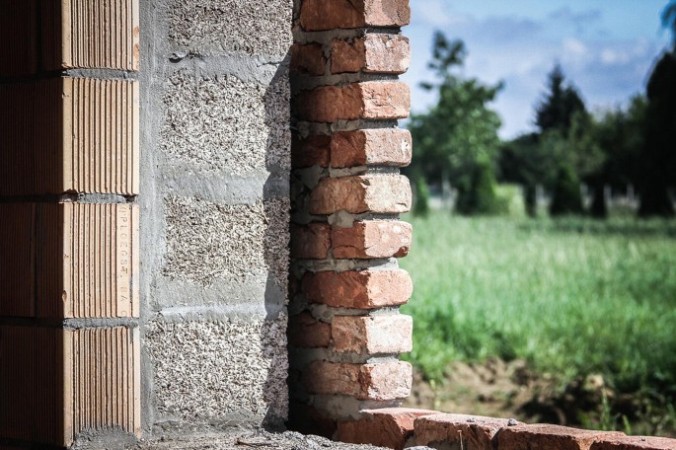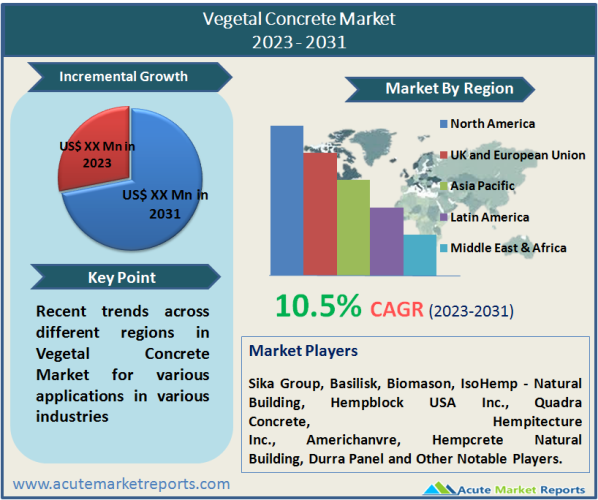
The global vegetal concrete market is projected to grow at a CAGR of 10.5% during the forecast period of 2025 and 2033. In the near future, the market for vegetal concrete is anticipated to be bolstered by a growing emphasis on minimizing the environmental impact of the manufacturing and use of conventional concrete. Government rules promoting sustainable construction techniques and a rise in green building initiatives are also anticipated to drive market growth in the coming years. Manufacturers of vegetal concrete are investing in research and development to enhance its performance, durability, and cost-effectiveness. In addition, they are partnering with other businesses, researchers, and government groups to stay aware of the most recent advancements in the industry and gain access to new markets and funding opportunities. Significant amounts of energy are required to produce concrete and other building materials. The manufacturing process generates significant greenhouse gas and carbon emissions. Vegetal concrete is a type of concrete produced by combining standard cement, aggregates, and organic materials, such as plant matter, to generate a more sustainable and eco-friendly building material. Organic matter enhances the thermal insulating characteristics of concrete, reduces its carbon footprint, and offers food and habitat for microbes and other living animals.

Demand Increase for Eco-Friendly and Sustainable Construction Materials Fuelling Vegetal Concrete Market Size
More than 40% of the world's energy consumption is absorbed by buildings. Buildings contribute significantly to global greenhouse gas emissions and the resulting climate change. The three sub-sources that contribute to carbon emissions are construction, operations, and destruction.
Using materials derived from crop residues and agroforestry wastes is a viable technique for reducing the energy required to operate a structure. Hemp, jute, sisal, flax, nettle, and pigeon pea crop residues are used to produce vegetal concrete, which is lightweight concrete. To reduce waste and maximize resource use, major enterprises in the building industry have begun employing vegetal concrete. This is anticipated to stimulate market growth for vegetal concrete shortly.
Vegetal concrete can absorb carbon dioxide. This concrete is an effective insulator and a non-toxic substance. It is recyclable and reusable. Vegetal concrete is carbon-negative, as the plant materials used to produce it absorb carbon dioxide to compensate for the carbon dioxide released during production. It does not necessitate the use of extra chemicals, resulting in healthier living areas and reduced environmental toxicity. Hence, the growth in demand for eco-friendly and sustainable construction materials is predicted to bolster vegetal concrete market expansion over the following several years.
Growth of the Construction Industry
Population growth has led to an increase in construction sector investment. Modern infrastructure blends innovative architectural elements, forceful technology, and premium, durable building materials to provide essential durability and longevity. Governments in numerous nations throughout the world are enacting tough laws to encourage the use of ecologically friendly and sustainable building materials. Via the Building Materials & Technology Promotion Council, the Indian government encourages and promotes the use of environmentally friendly, energy-efficient, and sustainable construction materials. Such activities are likely to increase market data for vegetal concrete shortly.
Significant Use of Hemp Concrete
According to the most recent market trends for vegetal concrete, the hemp concrete sector is anticipated to hold the highest share over the projection period. The compressive strength and density of hemp concrete are lower than those of conventional concrete. It is therefore appropriate for earthquake-prone regions. Hemp concrete's low density protects it from cracking during movement. It is also resistant to fire.
APAC to Dominate the Global Market
According to the most recent market projection for vegetal concrete, Asia Pacific is expected to dominate the global industry from 2025 to 2033. Increased investment in smart city initiatives and demand for eco-friendly building materials are driving market growth in the region. In the coming years, the frequency of natural disasters is also expected to increase the use of vegetal concrete in Asia-Pacific.
Strategic Collaborations to Enhance Market Share
The sector is moderately fragmented, with a handful of large-scale companies owning the majority of the market. Key players in this market include Sika Group, Basilisk, Biomason, IsoHemp - Natural Building, Hempblock USA Inc., Quadra Concrete, Hempitecture Inc., Americhanvre, Hempcrete Natural Building, and Durra Panel. The majority of corporations invest significantly in extensive research and development to manufacture environmentally friendly products. In addition, they are pursuing collaboration, partnership, and merger and acquisition tactics to expand their vegetal concrete market share.
Key market development in the market include:
Historical & Forecast Period
This study report represents analysis of each segment from 2023 to 2033 considering 2024 as the base year. Compounded Annual Growth Rate (CAGR) for each of the respective segments estimated for the forecast period of 2025 to 2033.
The current report comprises of quantitative market estimations for each micro market for every geographical region and qualitative market analysis such as micro and macro environment analysis, market trends, competitive intelligence, segment analysis, porters five force model, top winning strategies, top investment markets, emerging trends and technological analysis, case studies, strategic conclusions and recommendations and other key market insights.
Research Methodology
The complete research study was conducted in three phases, namely: secondary research, primary research, and expert panel review. key data point that enables the estimation of Vegetal Concrete market are as follows:
Market forecast was performed through proprietary software that analyzes various qualitative and quantitative factors. Growth rate and CAGR were estimated through intensive secondary and primary research. Data triangulation across various data points provides accuracy across various analyzed market segments in the report. Application of both top down and bottom-up approach for validation of market estimation assures logical, methodical and mathematical consistency of the quantitative data.
| ATTRIBUTE | DETAILS |
|---|---|
| Research Period | 2023-2033 |
| Base Year | 2024 |
| Forecast Period | 2025-2033 |
| Historical Year | 2023 |
| Unit | USD Million |
| Segmentation | |
Crop Residue
| |
Concrete Type
| |
Application
| |
End-use
| |
|
Region Segment (2023-2033; US$ Million)
|
Key questions answered in this report